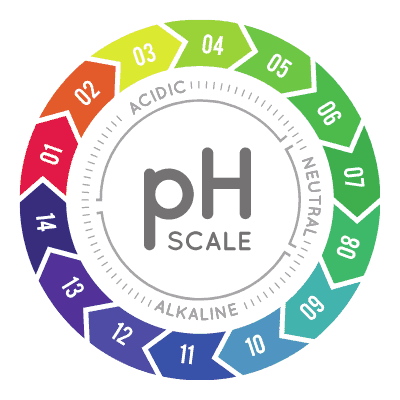If your well water tastes a little off, leaves blue-green stains on sinks, or has started eating away at your pipes — acidic water could be the culprit. Low pH levels aren’t just tough on plumbing, they can slowly corrode appliances and even affect your health over time.
The good news? There are simple, proven ways to balance your water’s pH — and protect your home from long-term damage. Whether you’re looking for a quick fix or a whole-house solution — this guide breaks down what causes acidic well water and how to safely raise the pH back to a healthy level.
✅ Key Takeaways
- 🧪 Low pH = acidic water — this can lead to pipe corrosion, metal leaching, and bitter taste.
- 🔬 Ideal pH range: The EPA recommends a pH between 6.5 and 8.5 for household water.
- 🧫 Common causes: Dissolved CO₂, mineral deficiency (like low calcium), or industrial runoff.
🧰 Fixes include:
- Acid neutralizer tanks (with calcite or corosex media)
- Soda ash injection (using a chemical feed pump)
- Remineralizing RO filters for balanced drinking water
💡 Pro Tip: Always test your water first. A simple TDS meter or lab kit can help confirm whether you’re dealing with pH issues — or something more complex.
💥 What Causes Low pH in Well Water?

Acidic water doesn’t just appear out of nowhere — it’s usually a mix of local geology, environmental factors, and natural water chemistry.
If your well water’s pH has dipped below the healthy range, one or more of these common causes could be to blame:
⚙️ Common Reasons for Low pH in Wells:
- Dissolved carbon dioxide (CO₂): Naturally acidic, CO₂ can lower water’s pH when absorbed underground.
- For a deeper dive: into how soil composition, rainfall, and local geology affect pH in private wells, this UMass guide breaks it down clearly.
- Low mineral content: Water lacking calcium or magnesium has poor buffering capacity, making it more acidic.
- Runoff contamination: Industrial or mining runoff can introduce acidifying compounds into groundwater.
- Decaying organic material: In some areas, leaf litter or swampy soil contributes acids to shallow wells.
- Rainfall and acid rain: Areas with high rainfall often have more acidic groundwater due to dilution and atmospheric CO₂ absorption.
🧪 Quick Reference — pH Ranges in Well Water:
- Surface wells: Typically 6.5–8.5
- Deep wells: Often range from 6.0–8.0 depending on local rock and soil
- Problematic: Anything consistently below 6.5 should be treated to prevent corrosion and health risks
💡 Good to Know:
Acidic water is often colorless and odorless — which makes it easy to overlook. But subtle signs like a bitter taste, corroded fixtures, or blue-green staining are often the first visible red flags.
🚨 Signs Your Well Water Might Be Too Acidic

The EPA recommends that drinking water fall within a pH range of 6.5 to 8.5 — but when your water dips below that, the effects can show up all over your home.
Here are some red flags that your well water is too acidic:
- ⚠️ Corrosion: Pinhole leaks, worn-out pipe threads, and rusted fittings — acidic water eats away at metal over time.
- 🚿 Blue-green stains: Often from copper leaching into your water and reacting with air — a classic sign of acidic plumbing.
- 💧 Metallic or sour taste: Low pH can create a tinny or bitter flavor in your tap water.
- 🔧 Frequent appliance issues: Water heaters, filters, and softeners may wear out faster when exposed to acidic water.
- 🧬 Health risks: When water is too acidic, it can slowly wear down your pipes — and that means metals like lead, copper, or manganese may sneak into your drinking water. Over time, that exposure adds up — it’s especially risky for kids or anyone with underlying health issues.
💡 Pro Tip: If your pH is low, test for heavy metals too — acidic water often increases their presence. You can use a lab-certified test kit to check for pH, lead, copper, and more.
🛠️ How to Treat Acidic Well Water (3 Proven Methods)

If your water test shows a pH below 6.5, it’s time to act. Fortunately, you’ve got a few solid options — whether you want a set-it-and-forget-it filter or something a bit more customizable.
⚙️ Option 1: Calcite Acid Neutralizer
A calcite neutralizer tank is one of the most common solutions for raising pH. It works by dissolving calcium carbonate (and sometimes magnesium oxide) into your water, slowly neutralizing acidity as water flows through the system.
✅ How it works:
Water enters a tank filled with calcite media. As it flows through, the acidic water dissolves a small amount of the mineral — gently raising the pH level.
✅ What to expect:
This system won’t purify your water, but it’s great for: neutralizing acidity and protecting your pipes and appliances from corrosion.
🧰 Maintenance tips:
- Re-bed the tank every 6–12 months depending on usage and pH level
- Backwash regularly to prevent media compaction
- Choose the right tank size for your household’s water demand
| ✅ Pros | ⚠️ Cons |
|---|---|
| Doesn’t require electricity | Can increase water hardness |
| Simple yearly maintenance | Less control over pH levels |
| Budget-friendly and long-lasting | May need a post-filter or softener |
| Protects plumbing and appliances | Doesn’t filter out other contaminants |
| Environmentally friendly option | Won’t protect the well pump or casing |
We’ve reviewed one of the most popular calcite neutralizer systems right here if you want to see what to expect before buying.
💡 Pro Tip: A calcite and corosex blend can raise your pH by up to 1.5 points — more than calcite alone. Just be cautious: too much alkalinity can create new issues.
⚙️ Option 2: Soda Ash Injection System
If you’re looking for more precision — and don’t want to deal with added hardness — a soda ash injection system might be your best bet. It raises pH by injecting a sodium carbonate solution directly into your water line, usually just before the pressure tank.
✅ How it works:
A chemical feed pump adds soda ash (sodium carbonate) into your water supply. The result? A more stable, neutral pH without the side effect of extra calcium or magnesium.
✅ What to expect:
This system gives you more control over how much pH adjustment is happening — and it won’t increase water hardness like calcite systems can.
🧰 Maintenance tips:
- Refill the soda ash solution tank every few weeks, depending on use
- Clean or replace pump screens regularly
- Mix fresh solution as needed — especially in warmer weather
- Service the feed pump annually for best performance
| ✅ Pros | ⚠️ Cons |
|---|---|
| Won’t raise water hardness | Requires electricity |
| Precise pH adjustment | Solution needs frequent mixing |
| No post-filter or softener needed | Higher upfront cost |
| Protects plumbing *and* your well system | More moving parts to maintain |
| Optional chlorine injection for added disinfection | Moderate environmental footprint |
💡 Pro Tip: If your water is also prone to bacteria, adding chlorine to your injection system gives you pH correction and disinfection in one go — no extra filter required.
⚙️ Option 3: Try a Remineralizing RO Filter
Reverse osmosis (RO) systems are known for filtering out nearly everything — from heavy metals to pesticides — but they also remove beneficial minerals. A remineralizing RO system solves that by rebalancing your water after filtration — helping raise pH and improve taste.
✅ How it works:
Water is first purified through a multi-stage RO system, removing dissolved solids and contaminants. Then, before it reaches your faucet, a remineralization filter adds alkaline minerals (like calcium or magnesium) back into the water — nudging the pH upward.
✅ What to expect:
You’ll get ultra-clean water that’s less acidic and more balanced for drinking. Just be aware that these systems are typically undersink setups, not whole-house.
🧰 Maintenance tips:
- Change pre- and post-filters every 6–12 months
- Replace the RO membrane every 2–3 years
- Choose a remineralization cartridge that suits your mineral preferences
- Keep an eye on water pressure — RO works best at 60+ psi
| ✅ Pros | ⚠️ Cons |
|---|---|
| Filters AND balances pH | Remineralization adds only small pH boost |
| Removes harmful contaminants | Not a whole-house solution |
| Improves taste and mineral content | Creates some wastewater |
| Great for drinking and cooking | Requires filter maintenance |
| Many systems now include alkaline stages | Higher initial cost vs. basic filters |
💡 Pro Tip: If you already use an RO system and your water tastes “flat,” a remineralization stage is a simple upgrade that improves both flavor and pH.
❓ Quick FAQ

🧪 How can I tell if my water is acidic and corrosive?
Start with a comprehensive water test. Corrosive water often has a pH below 6.5, plus elevated metals like lead or copper from pipe leaching. Some test kits also include corrosivity indexes to give you the full picture.
📏 How do I figure out what size neutralizer tank I need?
Check the label on your pipes or use the string method to measure circumference. If you have a 1” pipe, make sure the system you choose has 1” connectors — otherwise you’ll lose flow rate or need adapters.
🔍 What if I need to treat more than just low pH in my well water?
If your well has a mix of issues — like iron, sulfur, or sediment along with acidity — a single fix might not be enough. You’ll want a more comprehensive setup. We’ve put together a list of systems that handle multiple problems if you’re curious what might work best.
 97 people found this helpful. Was this guide helpful to you?
97 people found this helpful. Was this guide helpful to you? 

